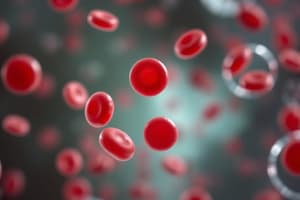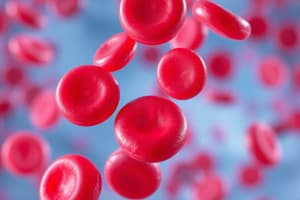Podcast
Questions and Answers
What is the primary function of platelets in the blood coagulation process?
What is the primary function of platelets in the blood coagulation process?
- To transport oxygen from lungs to tissues
- To produce antibodies to fight infection
- To form blood clots to stop bleeding (correct)
- To combat parasites and play a role in allergic reactions
What is the main function of red blood cells?
What is the main function of red blood cells?
- To form blood clots to stop bleeding
- To maintain blood pressure and transport hormones and fatty acids
- To transport oxygen from lungs to tissues and carbon dioxide from tissues to lungs (correct)
- To fight infection and produce antibodies
What is the primary function of neutrophils, a type of white blood cell?
What is the primary function of neutrophils, a type of white blood cell?
- To produce antibodies to fight infection
- To maintain blood pressure and transport hormones and fatty acids
- To transport oxygen from lungs to tissues
- To engulf and digest foreign particles and bacteria (correct)
What is the function of albumin, a protein in plasma?
What is the function of albumin, a protein in plasma?
What is the Rh factor in blood type compatibility?
What is the Rh factor in blood type compatibility?
What is the primary function of fibrinogen, a protein in plasma?
What is the primary function of fibrinogen, a protein in plasma?
What type of blood can an individual with type AB blood receive?
What type of blood can an individual with type AB blood receive?
What is the primary function of eosinophils, a type of white blood cell?
What is the primary function of eosinophils, a type of white blood cell?
What is the primary function of platelets in the blood vessel injury response?
What is the primary function of platelets in the blood vessel injury response?
Which of the following is a function of hemoglobin in red blood cells?
Which of the following is a function of hemoglobin in red blood cells?
What is the primary function of white blood cells in the immune response?
What is the primary function of white blood cells in the immune response?
Which plasma protein is responsible for forming blood clots?
Which plasma protein is responsible for forming blood clots?
What is the significance of type O negative blood in blood transfusions?
What is the significance of type O negative blood in blood transfusions?
Which of the following is a function of plasma proteins?
Which of the following is a function of plasma proteins?
What determines an individual's blood type?
What determines an individual's blood type?
What is the primary function of neutrophils and eosinophils in the immune response?
What is the primary function of neutrophils and eosinophils in the immune response?
What is the primary function of albumin in plasma?
What is the primary function of albumin in plasma?
What is the consequence of receiving incompatible blood in a transfusion?
What is the consequence of receiving incompatible blood in a transfusion?
Flashcards are hidden until you start studying
Study Notes
Platelets Coagulation
- Platelets (thrombocytes) are small, irregularly-shaped blood cells involved in blood coagulation
- Functions:
- Form blood clots to stop bleeding
- Release chemicals that attract white blood cells to fight infection
- Coagulation process:
- Injury to blood vessel
- Platelets aggregate to form a platelet plug
- Coagulation factors (e.g., thrombin) are activated
- Fibrin clot forms, trapping platelets and blood cells
- Clot retraction and dissolution
Red Blood Cells Oxygen Transport
- Red blood cells (erythrocytes) are biconcave disk-shaped cells that carry oxygen
- Functions:
- Transport oxygen from lungs to tissues
- Transport carbon dioxide from tissues to lungs
- Structure:
- Flexible cell membrane
- Hemoglobin protein binds to oxygen
- No nucleus or organelles to maximize space for hemoglobin
White Blood Cells Immunity
- White blood cells (leukocytes) are part of the immune system
- Functions:
- Phagocytosis: engulf and digest foreign particles and bacteria
- Antibody production: produce antibodies to fight infection
- Activation of immune responses
- Types of white blood cells:
- Neutrophils: phagocytosis
- Lymphocytes: antibody production
- Monocytes: mature into macrophages for phagocytosis
- Eosinophils: combat parasites and play a role in allergic reactions
- Basophils: involved in inflammation and allergic reactions
Plasma Protein Functions
- Plasma is the liquid portion of blood, comprising 92% water and 8% proteins and nutrients
- Protein functions:
- Albumin: maintains blood pressure, transports hormones and fatty acids
- Globulins: transport lipids, hormones, and vitamins
- Fibrinogen: converts to fibrin in blood coagulation
- Immunoglobulins: antibodies produced by B cells
Blood Type Compatibility
- ABO blood group system:
- A and B antigens on red blood cells
- Corresponding antibodies in plasma (A and B)
- Compatibility rules:
- Type A: can receive A or O blood, but only donate to A
- Type B: can receive B or O blood, but only donate to B
- Type AB: can receive AB, A, B, or O blood, but only donate to AB
- Type O: can receive O blood, but can donate to all types
- Rh factor:
- Rh+ (Rh positive): has Rh antigen on red blood cells
- Rh- (Rh negative): lacks Rh antigen on red blood cells
Blood Component Functions
- Platelets:
- Involved in blood coagulation
- Form blood clots to stop bleeding
- Release chemicals to attract white blood cells to fight infection
- Red Blood Cells:
- Carry oxygen from lungs to tissues
- Carry carbon dioxide from tissues to lungs
- Have flexible cell membrane and hemoglobin protein to bind oxygen
- Lack nucleus and organelles to maximize space for hemoglobin
- White Blood Cells:
- Part of immune system
- Engulf and digest foreign particles and bacteria through phagocytosis
- Produce antibodies to fight infection
- Activate immune responses
- Types: neutrophils, lymphocytes, monocytes, eosinophils, basophils
Blood Coagulation Process
- Injury to blood vessel
- Platelets aggregate to form platelet plug
- Coagulation factors (e.g., thrombin) are activated
- Fibrin clot forms, trapping platelets and blood cells
- Clot retraction and dissolution
Plasma Functions
- Comprises 92% water and 8% proteins and nutrients
- Albumin:
- Maintains blood pressure
- Transports hormones and fatty acids
- Globulins:
- Transport lipids, hormones, and vitamins
- Fibrinogen:
- Converts to fibrin in blood coagulation
- Immunoglobulins:
- Antibodies produced by B cells
Blood Type Compatibility
- ABO blood group system:
- A and B antigens on red blood cells
- Corresponding antibodies in plasma (A and B)
- Compatibility rules:
- Type A: can receive A or O blood, but only donate to A
- Type B: can receive B or O blood, but only donate to B
- Type AB: can receive AB, A, B, or O blood, but only donate to AB
- Type O: can receive O blood, but can donate to all types
- Rh factor:
- Rh+ (Rh positive): has Rh antigen on red blood cells
- Rh- (Rh negative): lacks Rh antigen on red blood cells
Blood Components
Platelets and Coagulation
- Platelets are small, irregularly-shaped blood cells that play a vital role in blood clotting
- Platelets are produced in the bone marrow through thrombopoiesis
- Platelets form a platelet plug when a blood vessel is injured, which is the initial step in the coagulation cascade
- Coagulation is the process of forming a blood clot to prevent excessive bleeding
- Platelets release chemicals that attract more platelets and facilitate the formation of a fibrin clot
Red Blood Cells and Oxygen Transport
- Red blood cells (RBCs) carry oxygen from the lungs to the body's tissues
- RBCs contain hemoglobin, which binds to oxygen and gives blood its red color
- Hemoglobin is composed of four polypeptide chains (globins) and four heme groups
- Oxygen binds to the iron atom in the heme group, allowing RBCs to transport oxygen to the body's tissues
- RBCs are flexible, disk-shaped cells that can change shape to fit through narrow blood vessels
White Blood Cells and Immunity
- White blood cells (WBCs) are a key component of the immune system
- There are several types of WBCs, including neutrophils, lymphocytes, monocytes, and eosinophils
- WBCs fight infection and disease by phagocytosing foreign particles and bacteria, producing antibodies, and activating the immune response
- WBCs also destroy infected cells or foreign substances
Plasma and Protein Functions
- Plasma is the liquid portion of blood that carries proteins, nutrients, and waste products
- Plasma proteins, such as albumin, globulins, and fibrinogen, have several important functions:
- Maintaining blood pressure and volume
- Regulating blood pH and electrolyte balance
- Transporting hormones, vitamins, and nutrients
- Supporting the immune response
- Helping to form blood clots
Blood Type Compatibility
- Blood type is determined by the presence or absence of specific antigens on the surface of RBCs
- There are four main blood types: A, B, AB, and O
- Each blood type has specific antibodies that react with incompatible antigens, leading to an immune response
- Type O negative blood is considered the "universal donor" type, as it can be transfused to anyone without triggering an immune response
Studying That Suits You
Use AI to generate personalized quizzes and flashcards to suit your learning preferences.




